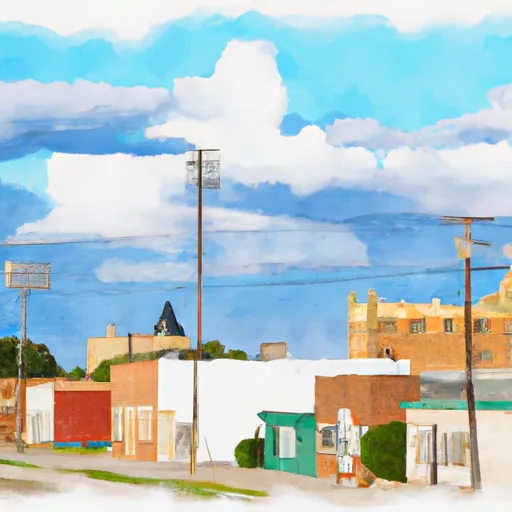-
 Snoflo Premium
Snoflo Premium
Get unlimited access to all our content
With no Ad interruptions! - Start Your Free Trial Login with existing account
Waurika
Eden Index
Climate
9.7
•
Recreation
1.2
•
Community
1.7
•
Safeguard
4.7/10

Waurika, Oklahoma is a small city located in Jefferson County in the southern part of the state. The climate in Waurika is considered to be humid subtropical, characterized by hot summers and mild winters. Average temperatures range from the mid-90s Fahrenheit (mid-30s Celsius) in summer to the mid-50s Fahrenheit (around 13 degrees Celsius) in winter.
Hydrology in Waurika is mainly influenced by the presence of Waurika Lake, a reservoir located to the northwest of the city. The lake is a popular spot for boating, fishing, and water sports, offering opportunities for outdoor recreation. Additionally, the lake provides a source of drinking water for the city.
Outdoor enthusiasts in Waurika can also enjoy other recreational activities such as hiking and camping at local parks and nature areas. The city is surrounded by picturesque landscapes and natural beauty, making it a great destination for those seeking outdoor adventures.
In conclusion, Waurika, Oklahoma, experiences a humid subtropical climate, with hot summers and mild winters. The presence of Waurika Lake offers opportunities for water-based recreation, while the surrounding areas provide ample space for hiking, camping, and other outdoor activities.
What is the Eden Index?
The Snoflo Eden Index serves as a comprehensive rating system for regions, evaluating their desirability through a holistic assessment of climate health, outdoor recreation opportunities, and natural disaster risk, acknowledging the profound impact of these factors on livability and well-being.
Climate Health Indicator (CHI): 9.7
Waurika receives approximately
804mm of rain per year,
with humidity levels near 79%
and air temperatures averaging around
18°C.
Waurika has a plant hardyness factor of
7, meaning
plants and agriculture in this region tend to thrive during the non-winter months.
By considering the ideal temperature range, reliable water supplies, clean air, and stable seasonal rain or snowpacks, the Climate Health Indicator (CHI) underscores the significance of a healthy climate as the foundation for quality living.
A healthy climate is paramount for ensuring a high quality of life and livability in a region, fostering both physical well-being and environmental harmony. This can be characterized by ideal temperatures, reliable access to water supplies, clean air, and consistent seasonal rain or snowpacks.
Weather Forecast
Streamflow Conditions
Red-Lake Texoma
Area Rivers
Red-Lake Texoma
Snowpack Depths
Red-Lake Texoma
Reservoir Storage Capacity
Red-Lake Texoma
Groundwater Levels
Recreational Opportunity Index (ROI): 1.2
The Recreational Opportunity Index (ROI) recognizes the value of outdoor recreational options, such as parks, hiking trails, camping sites, and fishing spots, while acknowledging that climate plays a pivotal role in ensuring the comfort and consistency of these experiences.
Access to outdoor recreational opportunities, encompassing activities such as parks, hiking, camping, and fishing, is crucial for overall well-being, and the climate plays a pivotal role in enabling and enhancing these experiences, ensuring that individuals can engage in nature-based activities comfortably and consistently.
Camping Areas
| Campground | Campsites | Reservations | Toilets | Showers | Elevation |
|---|---|---|---|---|---|
| Richardson State Park | None | 1,091 ft | |||
| Pelham City Park | 10 | 1,098 ft | |||
| Selma City Park - Lake Amon Carter | 21 | 920 ft | |||
| Kiowa Park - Waurika Lake | None | 979 ft | |||
| Lake Mineral Wells State Park | 105 | 875 ft | |||
| Wichita Ridge - Waurika Lake | None | 1,001 ft | |||
| Moneka Park - Waurika Lake | None | 906 ft | |||
| Wise County Park | 24 | 894 ft | |||
| Chisolm Trail Ridge - Waurika Lake | None | 975 ft | |||
| Hapgood RV Park | 12 | 881 ft |
Nearby Fishing
Nearby Ski Areas
Catastrophe Safeguard Index (CSI):
The Catastrophe Safeguard Index (CSI) recognizes that natural disaster risk, encompassing floods, fires, hurricanes, and tornadoes, can drastically affect safety and the overall appeal of an area.
The level of natural disaster risk in a region significantly affects safety and the overall livability, with climate change amplifying these risks by potentially increasing the frequency and intensity of events like floods, fires, hurricanes, and tornadoes, thereby posing substantial challenges to community resilience and well-being.
Community Resilience Indicator (CRI): 1.7
The Community Resilience Indicator (CRI) recognizes that education, healthcare, and socioeconomics are crucial to the well-being of a region. The CRI acknowledges the profound impact of these elements on residents' overall quality of life. By evaluating educational resources, healthcare accessibility, and economic inclusivity, the index captures the essential aspects that contribute to a thriving community, fostering resident satisfaction, equity, and social cohesion.

